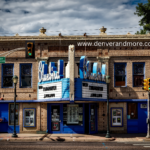Union Station, located in the heart of Denver, Colorado, is not just a transit hub but a symbol of the city’s rich history and ongoing evolution. Originally opened in 1881, Union Station has been a key player in Denver’s growth, serving as a gateway for travelers coming to the Mile High City. Its story is one of resilience and transformation, making it one of Denver’s most cherished landmarks.
A Rich History
Union Station’s beginnings trace back to the late 19th century when Denver was rapidly growing as a vital hub in the American West. The station, initially built to accommodate multiple railroad companies, has seen several transformations. After a devastating fire in 1894, the station was rebuilt in a Romanesque style, with the iconic clock tower added in 1914. Over the years, Union Station has witnessed the rise and fall of the American railroad industry, with passenger rail travel declining in the mid-20th century.
However, rather than fade into obscurity, Union Station adapted to the changing times. In the 1980s, the station was recognized as a historic landmark, and in 2002, Denver voters approved a plan to renovate and revitalize the aging structure. This led to a $54 million renovation project, completed in 2014, which transformed Union Station into a vibrant mixed-use space that retains its historic charm while offering modern amenities.
Modern Attractions and Transportation Hub
Today, Union Station is more than just a transportation center; it’s a destination in itself. The station now houses the Crawford Hotel, a luxury boutique hotel that occupies the upper floors of the building, offering a unique blend of historic and modern aesthetics. The Great Hall, often referred to as Denver’s living room, is a bustling space filled with restaurants, bars, and shops. Among the popular spots are the Terminal Bar, which offers a wide selection of craft beers, and Mercantile Dining & Provision, a restaurant known for its farm-to-table cuisine.
Union Station is also a key transportation hub, linking Denver to various destinations. It serves as the terminus for the University of Colorado A Line, which connects downtown Denver to Denver International Airport in just 37 minutes. Additionally, Amtrak’s California Zephyr line, which runs between Chicago and San Francisco, makes a stop at Union Station, providing scenic cross-country travel options. The station also connects with Denver’s light rail and bus systems, making it a central point for local and regional travel.
Best Facts About Union Station
- Historic Landmark: Union Station is listed on the National Register of Historic Places, preserving its legacy as a crucial part of Denver’s history.
- Architectural Marvel: The Beaux-Arts style façade, with its grand clock tower and ornate details, is a testament to early 20th-century architecture.
- Sustainability: The 2014 renovation was designed with sustainability in mind, incorporating energy-efficient systems and materials.
- Cultural Hub: Beyond transportation, Union Station hosts events, markets, and even pop-up shops, contributing to Denver’s cultural scene.
Conclusion
Union Station stands as a testament to Denver’s ability to honor its past while embracing the future. From its storied history as a railroad station to its current status as a modern transportation hub and cultural destination, Union Station continues to be a vital part of Denver’s identity. Whether you’re catching a train, staying at the Crawford Hotel, or simply enjoying a meal in the Great Hall, Union Station offers a unique glimpse into the city’s vibrant past and dynamic present.


